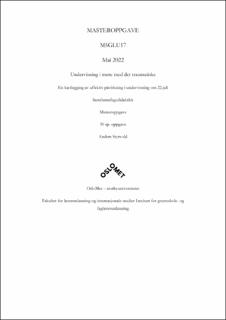| dc.description.abstract | De aller fleste voksne nordmenn husker hvor de befant seg, og hva de gjorde 22. juli 2011. Terrorangrepet rammet Arbeiderpartiet, og hardest deres ungdomsparti AUF. Anders Behring Breivik valgte å detonere en bombe i regjeringskvartalet, før han reise til Utøya hvor han skjøt og drepte 69 personer. I forbindelse med debatten som blusset opp rundt tiårsmarkeringen, og at hendelsen er en av få som er eksplisitt omtalt i den nye læreplanen LK20, vil det være interessant å belyse hvilke følelser som kan oppstå i undervisning knyttet til 22. juli. Samtidig er undervisningspraksis rundt 22. juli allerede belyst i forskning og masterarbeid, og i den sammenhengen vil jeg forsøke å belyse hvilke affektive diskurser som fremmes i 22. juli-senterets undervisningsressurser produsert for bruk i Osloskolen. Begrepet historisk empati vektlegges i læreplanen, og det settes i dette arbeidet søkelys på hvordan dette kan fremmes i arbeid med 22. juli. Videre blir filmen Utøya:22-juli av Erik Poppe analysert med ønske om å kartlegge tilsvarende elementer. Metodisk fremgangsmåte for å finne frem de ulike affektive diskursene og hvordan historisk empati fremmes er kritisk diskursanalyse, etter modell fra Norman Fairclough. Funnene drøftes i lys av relevant teori, hvor Sarah Ahmed og Martha Nussbaums teorier i forbindelse med politiske følelser er fremtredende i arbeidet med affektive diskurser. Hatlens tanker rundt historisk empati, i kombinasjon med hva Kjøstvedt og Lund skriver om historisk tenkning og historiebevissthet blir videre drøftet opp mot analysens resultater, for å forsøksvis sette historisk empati i undervisning i kontekst. Avslutningsvis oppsummeres oppgavens analyse- og drøftingskapittel med at elevene gjennom de tilgjengelige affektive diskursene blir invitert til å innta perspektivene til de faktiske aktørene i hendelsen. De eksponeres for et mangfold i meninger, ytringer og handlinger som åpner for at de kan vurdere de ulike perspektivenes gyldighet og bakgrunn. Elementer med potensiale til å fungere engasjerende i arbeidet med historiske hendelser, og eksplisitt med 22. juli, en hendelse de selv sannsynligvis ikke har egne erindringer fra.
If you ask any given Norwegian adult about where they were or what they were doing on the 22nd of July 2011 you’d probably get a precise answer. The terrorist attack that found place on that day were intended to hit the Norwegian Labour party, and it hit their youth party the hardest. Anders Behring Breivik detonated a bomb in Oslo city centre, before travelling to Utøya, where he shot and killed 69 people. In conjunction with the ten-year anniversary, and the fact that the attack is specifically mentioned in the updated curriculum for the middle schools of Norway, it will be interesting to look closer to how the attack is presented in the classrooms using certain recourses. On the other hand, the teaching practice surrounding 22nd of July is already researched through multiple journals and master’s degrees. In my own work, I will try to find out how affective discourses and historical empathy comes to show in teaching recourses made for this thematic through an analysis. Aside from the teaching recourses, the movie Utøya:22-juli will be analysed, and the method used for this project will be a critical discourse analysis, from the model made by Norman Fairclough. The findings will be discussed considering relevant theoretical perspectives, where Sarah Ahmed and Martha Nussbaum´s theories surrounding political emotions will be important to shed light to the affective discourses. Historical empathy, presented by Jan Frode Hatlen will, combined with the thoughts of Kjøstvedt and Lund regarding historical thinking and historical consciousness, be discussed with reference to the results of the analysis. This will be an attempt to put historical empathy in context with classroom education. In conclusion, the chapters containing the analysis and discussions will be summed up. In final it will tell that the pupils are being invited into new perspectives through understanding the affective discourses, and how emotions are central in historical events. The pupils are exposed for multiple ideologies, utterances and actions that works as a way in to considering the perspectives of the historical participants. These elements contain a potential to engage pupils through historical events, and in this case 22nd of July explicitly, an event which they probably don’t have memory from themselves. | en_US |
